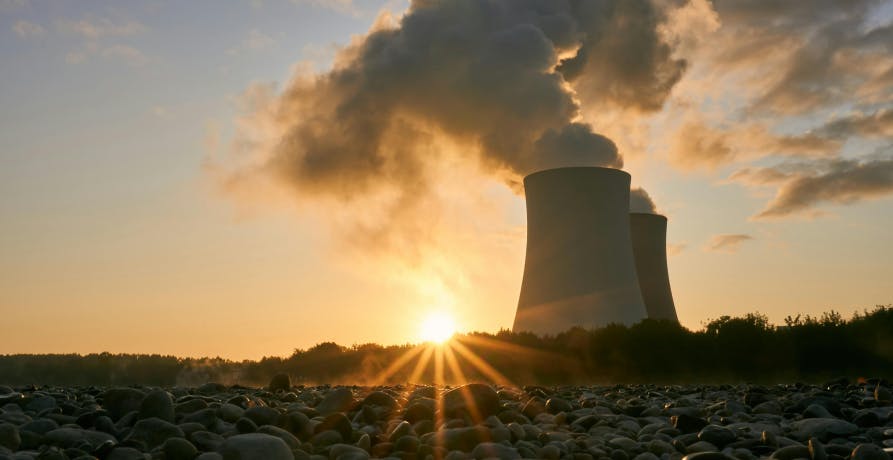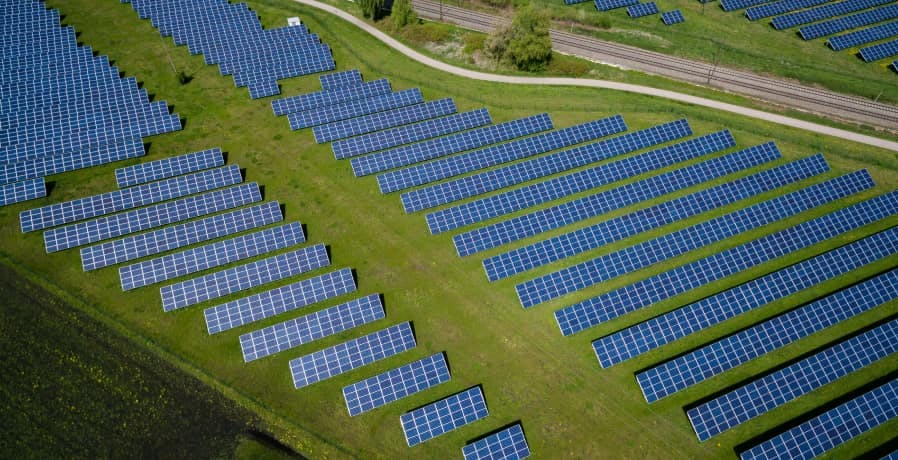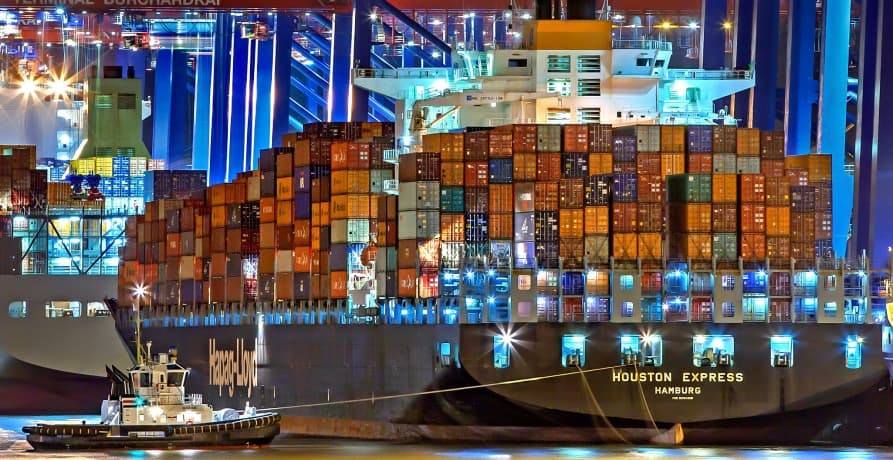| Energy Source |
2020 (%) |
2021 (%) |
2022 (%)
| 2023 (%) |
% Change 2020-2023 |
| Gas |
39.6 |
40 |
38.5 |
32 |
-19.19% |
| Wind |
24.3 |
22 |
26.8 |
29.4 |
+20.99% |
| Nuclear |
16.1 |
16 |
15.5 |
14.2 |
-11.80% |
| Biomass |
5.7 |
6 |
5.2 |
5 |
-12.28% |
| Coal |
1.8 |
2 |
1.5 |
1 |
-44.44% |
| Solar |
4.2 |
3.9 |
4.4 |
4.9 |
+16.67% |
| Imports |
6.3 |
5 |
5.5 |
10.7 |
+69.84% |
| Hydro |
1.6 |
1.5 |
1.8 |
1.8 |
+12.50% |
UK energy mix observations
Natural gas
Natural gas is currently the number one source of energy in the UK, which is problematic since it is a fossil fuel that is very damaging to the environment and a significant emitter of CO2. Thankfully, the UK Government is working towards decarbonization as outlined in the UK's Energy Security Plan. This plan emphasizes the need to reduce reliance on fossil fuels and promote cleaner energy sources to meet the 2050 net-zero target. This push towards decarbonization is a key reason why natural gas usage has been decreasing year on year from 2020 to 2023, showing a decline of nearly 20%.
It's also notable that the UK imports around 50% of its gas supply, which has led to several challenges regarding cost and supply. Increased demand for gas in Asia and diminished supplies from Russia, particularly due to the war in Ukraine, have caused UK consumers to face rising gas bills. These rising costs risk decreasing public support for decarbonization and green policies.
These challenges highlight the urgency for the UK to diversify its energy sources and reduce its reliance on imported fossil fuels. Transitioning towards more sustainable and secure energy sources is critical to achieving the country's decarbonization and energy security goals.

Wind power
Wind energy has shown substantial growth, increasing by about 21% over the past three years. This growth is largely due to the UK's significant investments in wind power infrastructure, particularly offshore wind farms. The government has supported these developments through various policies and subsidies, making wind power an increasingly vital part of the UK's energy supply.
What's notable is that the UK Government has favored offshore wind over onshore facilities. This preference became apparent in 2016 when the Tory Government cut subsidies for onshore wind projects, aiming to reduce the number of what some considered "unsightly" structures in the countryside. Although this policy has been partially reversed, planning restrictions still make the development of onshore wind farms challenging.
Interestingly, onshore wind is the cheapest and fastest method for scaling up renewable energy. Many experts and advocates argue that the UK Government should do more to support onshore wind projects to accelerate the transition to renewable energy. Despite these challenges, the overall increase in wind energy capacity highlights the UK's commitment to expanding its renewable energy portfolio and reducing its carbon footprint.
Nuclear energy
The UK's nuclear power stations are coming to the end of their operational lives, with all but one power station due to close by 2035. This situation has resulted from a lack of investment in the early 2000s and 2010s, which meant that no new nuclear reactors were developed. The absence of political incentives can be attributed to the high costs, technical challenges, political controversies, and long timelines required to develop nuclear power stations.
As a result, the UK's current nuclear facilities are aging and in dire need of replacement. There has been a gradual decline in nuclear energy's share, dropping by almost 12%, partly due to the recent closures of key facilities such as Hunterston B and Hinkley Point B. Although the UK plans to replace these with new nuclear projects, these initiatives will take time to come online.
The UK Government is only now waking up to the potential of nuclear energy, recognizing its importance in achieving energy security and reducing carbon emissions. We can expect to see a renewed focus on nuclear energy as part of the broader strategy to transition to cleaner and more reliable energy sources.

Biomass
Biomass energy is the second-largest source of renewable energy in the UK. It's generated from burning wood, plants, and organic matter. Although it releases carbon dioxide when burned, the emissions are significantly less than those produced by burning fossil fuels. Currently, the UK relies heavily on wood pellet imports to fuel its biomass power stations, but there are plans to potentially grow bioenergy crops domestically.
One of the primary benefits of biomass energy is that it is not weather-dependent like solar panels or wind turbines, making it a constant and reliable source of energy. This stability is a significant advantage, especially when integrated with other renewable sources that can be more intermittent.
However, biomass usage in the UK has slightly decreased, indicating a steady but minor reduction in its contribution to the energy mix. This decrease may be due to a growing emphasis on other renewable sources and the relatively higher costs associated with biomass energy. Additionally, there are environmental concerns related to the sourcing and transportation of biomass materials.

Coal
Energy supplied by coal is incredibly polluting. Burning this fossil fuel releases vast amounts of carbon dioxide and other pollutants into the environment, significantly contributing to climate change and damaging public health. Historically, coal was the primary means of producing power in the UK during the first half of the twentieth century. However, awareness of its environmental and health impacts has led to a significant reduction in coal usage.
The most dramatic change in the UK's energy mix is seen in coal usage, which has decreased by over 44% from 2020 to 2023. This reduction aligns with the UK's commitment to phasing out coal-fired power plants by October 2024 as part of a broader strategy to reduce greenhouse gas emissions and transition to cleaner energy sources. The government's decisive action to phase out coal power is a critical step in the UK's efforts to eliminate its reliance on this highly polluting energy source and move towards a more sustainable and environmentally friendly energy system.

Solar
Despite the UK's infamous bad weather, it is actually one of the top countries in the world for generating electricity using solar panels. In the UK, there are about 1,000 solar farms and over a million houses with solar panel installations, which equates to about 4.5% of UK homes generating electricity from solar power. The UK Government plans to increase the supply of solar energy as part of its broader strategy to decarbonize the energy sector.
Solar energy has seen a steady increase, growing by around 17% over the past few years, reaching a new solar generation record. This growth is driven by advances in solar technology, government incentives, and the increased installation of solar panels. The UK's strategy includes continued support for solar energy, making it a key component of the renewable energy portfolio.
The government's commitment to solar energy is evident through various policies and subsidies aimed at encouraging the adoption of solar technology. Despite the challenges posed by the UK's weather, the efficiency of modern solar panels and the growing number of installations demonstrate the viability and importance of solar power in the UK's energy mix.

Hydro
The vast majority of the UK's hydropower comes from the mountainous regions of Scotland and Wales. This type of power is generated from flowing water, either from natural rivers or man-made installations, where turbines extract energy from the water flow. Hydropower is a reliable and consistent source of renewable energy, providing a steady supply regardless of weather conditions.
However, many of the UK's current hydroelectric sites were built in the 1950s and 1960s. Recent proposals for new hydro sites have faced significant challenges due to environmental concerns. Many of the suitable mountainous sites for hydropower generation lie in protected areas, making development difficult and raising concerns about the impact on local ecosystems.
The share of hydroelectric power in the UK's energy mix has remained relatively stable with a slight increase, reflecting its consistent but limited role. Hydropower continues to be a reliable source, though its potential for expansion is limited compared to other renewables like wind and solar.
Imports
The UK electricity network is connected to France, the Netherlands, Norway, Belgium, Denmark, and Ireland via interconnector cables, allowing for the import and export of electricity. Historically, the UK has imported most of its energy from France and the Netherlands to meet its energy demands, while exporting to Ireland.
In 2023, there was an increase in energy imports, indicating a higher dependency on imported energy. This rise is likely due to transitional phases in domestic production and temporary reductions in nuclear and gas outputs. However, the overall decline in North Sea gas production and policies to cut oil and gas demand mean that the UK may become even more reliant on imports over the next five years.
This contrasts with the UK's desire to become more energy-independent. Geopolitical events such as the war in Ukraine highlighted the importance of reducing reliance on overseas energy sources and becoming more self-reliant. Investing in domestic renewable energy sources and enhancing energy storage capabilities are critical steps toward reducing reliance on imports and ensuring long-term energy security.

Storage
Energy storage facilities are essential for the UK to reduce its reliance on fossil fuels, as they help to fill energy supply gaps from weather-dependent technologies like wind and solar. Energy storage systems can absorb excess power when demand is low, saving it for later use, which enhances grid reliability and efficiency.
The UK has made significant investments in energy storage, and in 2022, one of Europe's largest battery storage systems went live in the UK. This development marks a crucial step towards achieving net-zero targets by ensuring energy security and reducing reliance on imports.
Energy storage has shown the most significant growth in the UK's energy sector, with a 150% increase. This growth is critical for balancing supply and demand, especially with the increasing integration of intermittent renewable energy sources. By enhancing storage technologies, the UK supports its renewable energy transition, creating a more resilient and self-sufficient energy system.
The importance of a diverse energy mix for the UK
In the UK, generating electricity from a variety of sources is crucial for maintaining energy security and ensuring a constant supply. Relying on multiple energy sources has several benefits:
- Reliability and stability: A diverse energy mix ensures that the UK does not become overly dependent on any single source of energy. This is important because it minimizes the risk of supply disruptions. For example, if one energy source is temporarily unavailable or reduced (e.g., due to maintenance, weather conditions, or geopolitical issues), other sources can compensate to maintain a steady supply of electricity.
- Energy security: By utilizing different energy sources, the UK can protect itself against external shocks and market volatility. This approach helps in managing risks associated with fuel price fluctuations and supply chain disruptions.
- Environmental impact: A balanced energy mix supports the transition towards cleaner and more sustainable energy. While fossil fuels like gas still play a role, increasing the share of renewables reduces greenhouse gas emissions and helps the UK meet its climate targets. The diversity in energy sources allows for a gradual shift towards greener energy without compromising supply reliability.
- Economic benefits: Investing in a range of energy sources stimulates economic growth and job creation across different sectors. It also encourages technological innovation and competition, which can lead to cost reductions and improved efficiency in energy production and consumption.
- Flexibility and adaptability: A mixed energy portfolio provides the flexibility to adapt to future changes in energy demand and technology advancements. As new technologies emerge and energy needs evolve, a diverse energy system can integrate new sources more seamlessly.
By maintaining a balanced mix of energy sources, the UK can ensure a reliable, secure, and sustainable energy supply. This strategy not only addresses immediate energy needs but also supports long-term goals for economic growth and environmental protection.

The UK Energy Security Strategy
“Published in April 2022, the British Energy Security Strategy laid out plans for speeding up the UK's energy transition to improve energy security and develop greater energy independence. Building on this, the UK Government released the 'Powering Up Britain: Energy Security Plan' in March 2023, further detailing steps to enhance energy independence and resilience.”
Key targets and commitments
Wind energy:
- The UK Government plans to significantly increase wind energy capacity from the current 11GW to 50GW by 2030. This expansion includes a focus on offshore wind, leveraging the UK's favorable conditions for wind energy development.
Solar energy:
- Solar capacity is set to grow from 14GW to 70GW by 2035. This ambitious target reflects the UK's commitment to zero carbon generation of electricity.
Hydrogen:
- The strategy commits to doubling the UK's hydrogen production capacity to 10GW by 2030, positioning hydrogen as a key component of the future energy mix.
Nuclear power:
- The UK plans to triple its nuclear power output by 2050, aiming for nuclear to supply 25% of the energy mix. This includes the development of new nuclear facilities and the consideration of small modular reactors (SMRs).
- Establishment of Great British Nuclear to lead the new nuclear program backed with the necessary funding.
- A competitive process to select the best SMR technologies - the process is currently ongoing, with a handful of companies already invited to bid for government contracts.
Energy storage and grid expansion:
- Investment in energy storage technologies is critical for balancing supply and demand, especially with intermittent renewable sources like wind and solar. One of Europe's largest battery storage systems went live in the UK in 2022, exemplifying these efforts.
- A Future Systems Operator (FSO) will be operational by 2024 to ensure energy resilience and integration of renewable technologies into existing infrastructure. ESO announced that the new organization will be called the National Energy System Operator (NESO) and that it is working towards a launch date of summer 2024.
Additional initiatives
- Launch of the Floating Offshore Wind Manufacturing Investment Scheme, providing up to £160 million for port infrastructure projects.
- Publication of action plans to reduce development time for transmission network projects and accelerate electricity network connections.
- The UK government awarded funding to 11 successful electrolytic hydrogen projects in December 2023 under its first hydrogen allocation round.
- Revised energy National Policy Statements to expedite planning processes for new energy infrastructure.
Addressing energy security and independence
The UK's energy strategy also emphasizes reducing reliance on imports and enhancing energy security in response to geopolitical events like Russia's invasion of Ukraine. The strategy aims to:
- Ensure the UK is more energy-independent, secure, and resilient by transitioning to a low-carbon electricity supply.
- Continue domestic oil and gas production while increasing renewable energy output.
- Develop strong international partnerships for reliable energy imports and exports.
Economic and environmental benefits
The strategy aligns with the Net Zero Growth Plan, aiming to improve the UK's competitiveness, attract investment, and support job creation across the nation. By increasing the supply of low-carbon energy and enhancing energy efficiency, the UK aims to achieve cheaper, cleaner, and more secure energy, ultimately benefiting both the economy and the environment.
The future of renewables
Zero-carbon power sources in the UK's electricity mix outperformed traditional fossil fuel generation in 2023 reflecting the country's commitment to producing zero carbon electricity. Clean power generation is crucial to the UK Government's strategy to reach net zero by 2050, and in recent years, they have set ambitious renewable energy targets, aiming to decarbonize the UK's power system.
Feasibility and challenges
The Climate Change Committee (CCC) - an independent body that advises the government on emissions targets - has stated that a massive ramp-up of renewable energy is required to meet the UK's electricity demand. This will likely involve significant increases in onshore and offshore wind, solar power, and battery storage capacity. According to the CCC, achieving these goals will necessitate substantial investment in infrastructure, with estimates suggesting up to £200 billion may be required. Investment will need to reach £50 billion a year by 2030 to meet these ambitious targets.
Recent policy changes
The UK's recent green policy u-turns have raised questions about the feasibility of these targets. The UK Government recently announced a delay to the ban on the sale of petrol and diesel cars, as well as the decision to grant more North Sea oil and gas licenses. These policy shifts could potentially slow down the transition to renewable energy and affect the UK's ability to meet its decarbonization goals.
Political landscape
The upcoming UK election will also play a critical role in shaping the future of the UK's renewable energy policies. Depending on the election outcome, there could be significant changes in the approach to green policies and investment in renewable energy. The political landscape will undoubtedly impact the pace and direction of the UK's energy transition.
Investment and infrastructure
To achieve the 2035 target, the UK will need to significantly boost investment in renewable energy infrastructure. This includes not only expanding renewable energy sources like wind and solar but also enhancing battery storage capacity to ensure a reliable supply of electricity. The establishment of a Future Systems Operator (FSO) in 2024 will be crucial for integrating renewable technologies into the existing infrastructure and ensuring energy resilience.
Round up
The future of renewables in the UK looks promising but is fraught with challenges. Achieving the ambitious targets set by the government will require substantial investment, policy stability, and strong political will. The recent policy reversals and the upcoming election will be pivotal in determining whether the UK can maintain its trajectory towards a cleaner, more sustainable energy future.

How Greenly Can Help Your Business Reduce Emissions
Greenly offers practical solutions to help your business excel in environmental sustainability by cutting down carbon emissions and adopting greener practices. Here’s how we can support your journey:
Measurement of GHG Emissions
- Comprehensive emission tracking: Measure Scope 1, 2, and 3 emissions for a full understanding of your carbon footprint.
- Advanced technology: Use the latest tools to accurately measure your carbon footprint, analyze emissions, and set achievable reduction targets.
- User-friendly interface: Use Greenly’s intuitive platform to calculate and monitor your business’s carbon footprint, ensuring a smooth carbon assessment process.
Custom Action Plans
- Expert support: Collaborate with Greenly’s climate experts to develop tailored action plans.
- Seamless assessment: Identify key areas for improvement and implement effective changes.
Decarbonizing Your Supply Chain
- Supplier engagement: Work with suppliers to reduce carbon emissions throughout your supply chain.
- Sustainable sourcing: Transition to low-carbon suppliers and build greener partnerships.
- Scope 3 emissions management: Achieve greater transparency and manage Scope 3 emissions effectively.
With Greenly’s help, your business can significantly reduce its environmental impact, meet ESG goals, and enhance sustainability while making informed business decisions. Contact us today to start your journey towards a greener future.
Subscribe to the CSO Connect Newsletter
We care about your data in our privacy policy.

















